|
|
Advertisement:
|
|
Inno3D GeForce 7600GS AGP Video Card |
|
Join the community - in the OCAU Forums!
|
Usage, Image Quality, Value, Conclusions
Heat & Noise:
Speaking of heat, the card runs quite cool at stock speed, even after a gaming session. The NVIDIA Control Panel has an option to allow fan speed control, and although I didn't observe this in action, the card is very quiet - even when gaming. The Zalman CNPS9500 CPU cooler used in the test PC is not very loud but completely drowned out the sound of the video card fan. I literally couldn't hear any difference with the high-tech test of stopping the video card fan with my finger and letting it spin up again. I have no problem recommending this card for an HTPC or other quiet environment.
Image Quality:
One complaint I did have was the image quality when using the SVGA connector in 1920x1200. There was a noticeable ghosting effect on the edges of windows and particularly on light text on a darker background. It's only a tiny shadow but it makes the text look fuzzy and I found it quite annoying. It's not noticeable when gaming and doesn't happen at all when using the DVI connector - but it still appeared when using the SVGA connector with DVI adapter. I asked Inno3D about this and their rather odd response was, and I quote, "i would suggest you use DVI output for graphics. if you insisted to use VGA then try 1280x1024 resolution. normally gamers use DVI output thou." That's not too useful when you're forced to use the SVGA connector - for example, my main PC ONLY has DVI connectors and my monitor has one each of DVI and SVGA. Besides, my trusty old R9800 Pro was fine in this resolution via the VGA adapter!
However, after fiddling with the NVIDIA Control Panel for a while I discovered a "Display Optimisation Wizard" and, loathe though I am to use wizards, it actually improved things quite a lot. The effect is still noticeable if you look for it, but it's not annoying in general use and I can quite happily use the SVGA connector in 1920x1200 now.
As for gaming quality, here's some screenshots from Far Cry. These are all 1920x1200 and maximum on all settings, which is a little unrealistic because it's completely unplayable on the R9800 Pro and not great on the 7600 GS. But I figure for image quality comparisons you want to have the best possible baseline, so here they are. These are exactly as saved by Far Cry.
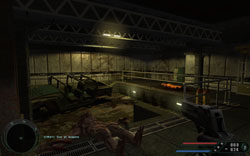 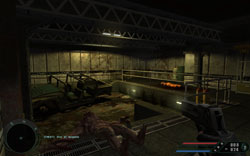
GeForce 7600 GS AGP - Radeon 9800 Pro
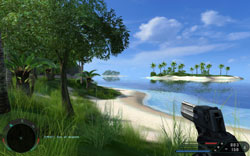 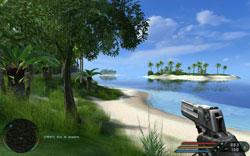
GeForce 7600 GS AGP - Radeon 9800 Pro
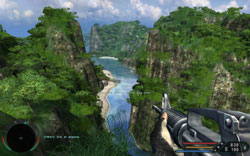 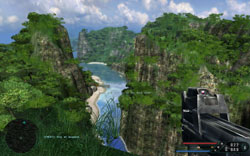
GeForce 7600 GS AGP - Radeon 9800 Pro
..and here's some 1600x1200 ones from the Prey demo. Prey saves screenshots as TGA files, so these are converted to JPG at Maximum Quality (100%) in Photoshop.
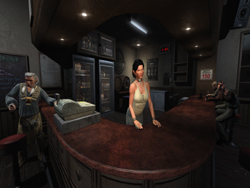 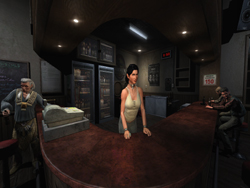
GeForce 7600 GS AGP - Radeon 9800 Pro
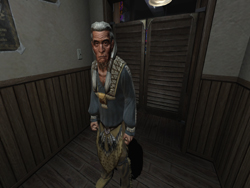 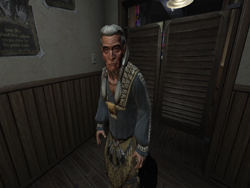
GeForce 7600 GS AGP - Radeon 9800 Pro
To be honest I don't really see anything really leaping out at me as a huge difference. Bear in mind that there can be differences which don't show up in screenshots (because they affect the image between where screenshots are taken and the physical display itself) but during gameplay and taking these screenshots I again couldn't see a huge difference.
TV-Out and HDTV:
I don't actually have an HDTV-capable TV, but my Dell 2405FPW has component input and can handle HDTV. I played around a bit on both the Dell and my trusy old 68cm Sony Trinitron TV and the image quality on both was extremely good. I checked out a few stills and videos and it works fine. In fact, I could even do normal Windows desktop stuff on my TV which previously has been quite painful and fuzzy via TV-Out. So this card will definitely be being used in my HTPC from now on.
Other Cards?
So, we've established that it IS worth considering a relatively cheap upgrade for an AGP-based machine, if you want to extend its gaming life and delay the larger cost of a PCI-E motherboard and video card - and in many cases, a new CPU, memory and possibly even PSU may be required. But is the 7600 GS the best bang for buck?
I think if you're considering upgrading your AGP machine for current and future games, a 7600 GS would be about the lowest performance you'd want to invest in right now. Otherwise you're not really buying that much more headroom. As mentioned earlier this is a mid-range card, and there are certainly faster options. The 7800 GS, for example, is also available on AGP.
The muddle of chipset versions and manufacturer variants make it tricky to work out which card is better than which in terms of performance, even when digging up reviews on the net. So my simple approach was to check out the three retailers who are OCAU Major Sponsors and see what other chipsets they offer on AGP around the same price as this Inno3D card.
PlusCorp list this Inno3D 7600 GS AGP card for $204. They don't really show a lot of other options for AGP at about the $200 mark. The Inno3D 7300 GT is $170 but offers lower performance, while the next highest AGP card is a Leadtek 6600TD at $252, out of our range.
Computer Alliance list the Palit X1600 Pro at $189 and their X800GTO at $229. The X1600 Pro is the ATI card that the 7600 GS basically directly competes with. TrustedReviews found the Sapphire X1600 Pro to perform roughly on par with the Inno3D 7600 GS AGP, while NGOHQ say they would choose the Inno3D 7600 GS AGP over the X1600 Pro. I couldn't find any reviews directly comparing the X800 GTO with 7600 GS on AGP but from online anecdotes it might be worth considering - hard to say if the price jump is worthwhile, though.
EYO interestingly have a Leadtek 6800XT for $211.31 and a 6600GT for $217. In this review an MSI 7600GS beats a 6600GT. I couldn't find a comparison with the 6800XT but based purely on the specs (see here) I can't see it beating the 7600 GS - you also wouldn't get the newer features of the 7xxx series, if that concerns you.
I realise that's a fairly wishy-washy way to compare cards but without doing a big overkill roundup it's a difficult topic to address. A google turns up a fair bit of forum chatter recommending the 6800 GS over the 7600 GS on AGP, but it seems to range from $50 to $75 more, so it's difficult to recommend as a direct competitor. Bear in mind though that if you do feel comfortable spending more than about $200 on your AGP upgrade, there are various other options. Be aware though that you are pretty much spending money on end-of-life equipment, with AGP well on the way out in terms of further upgrades in future.
What we can say from this exercise is that the Inno3D 7600 GS AGP is certainly not overpriced for its performance compared to other available cards, and seems in fact to be quite well positioned.
Conclusions:
The stated goal of this article was to find out if it's worthwhile spending about AUD $200 on this Inno3D 7600 GS AGP card to extend the life of an otherwise fairly powerful AGP system with an AGP card that is showing its age. The short answer is: yes! On our testbed PC we made modern games a lot more playable in medium to high resolutions. This card also seems to fit very neatly into its niche in terms of price vs performance. We did have some issues but they were either resolved or are unlikely to apply to the retail product you'll get. It seems a sensible move for people wanting to enjoy modern games while they delay their move to PCI-E, which is probably a lot of people given the imminent arrival of Vista, DX10 cards and multi-cored CPUs. Recommended!
Thanks to InnoVISION Multimedia for providing the review sample, and, in particular, to Caroline for her patience. :)
If you enjoyed this review and you're a Digg member, please Digg it!
|
|
Advertisement:
All original content copyright James Rolfe.
All rights reserved. No reproduction allowed without written permission.
Interested in advertising on OCAU? Contact us for info.
|

|


